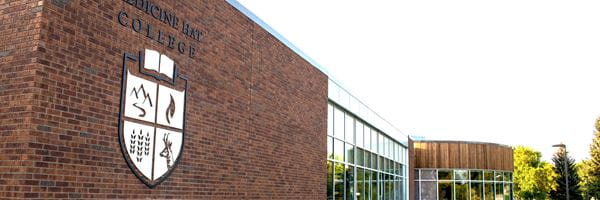MHC students learn to assess soil health in Medicine Hat
As they prepare for careers in reclamation, students in Medicine Hat College (MHC) Environmental Biology & Reclamation Technology (EBRT) are learning the processes behind identifying plant species, assessing land, and determining soil health, which are skills valued by employers.
The program provides students with the knowledge and skills to aid in returning disturbed lands to economically productive or natural habitats. In EREC 210: Agrology and Agro-ecology for Environmental Technologists, students study the agriculture industry and learn to assess tame pasture, field crops, and native grasslands.
 Students Oliver Bell, Isaiah Hurlbut, and Harmanpreet Kaur assess the types of plants and soil in a grassy field.
Students Oliver Bell, Isaiah Hurlbut, and Harmanpreet Kaur assess the types of plants and soil in a grassy field.
Instructor, Brent Smith, emphasizes the advantage of hands-on learning. As part of the course, students assess the health of soil, a common practice in diagnosing problems on sites.
“They need to understand soils, be able to read maps, and use databases,” says Smith. “Once they're on the ground, they’ll actually start to measure what kind of soil it is, how deep the topsoil layer is, and be able to identify all of the plants that grow on the site.”
The results of their assessments can numerically evaluate the health of land.
Working in groups, the students are reviewing samples and collecting data on different plant species in the area. The information they find will allow them to compare an ideal plot of agricultural land in their final report.
“I am really appreciative of all of the hands-on opportunities we get in this program. I think that without them, I would not have the amount of knowledge I do now,” says Oliver Bell, second-year student. “I absolutely enjoy being outside, and how many courses can say that they can do that.”
 Oliver Bell documents his findings on a Range Inventory Form.
Oliver Bell documents his findings on a Range Inventory Form.
For Harmanpreet Kaur, the project connects directly to her agricultural roots.
“I enjoy learning about the environment and working with animals. It’s useful for me and my family back home in India,” she says. “These skills can help improve our practices there.”
Kaur also highlights the program’s broader training, including plant taxonomy and animal handling, skills she applied during a recent field trip to Elkwater, where students interacted with baby barn owls.
While many graduates enter the workforce after earning their diploma, others pursue further education.
“When I applied, I just knew I wanted to work outdoors,” says student, Isaiah Hurlbut. “This program gave me a broad introduction to environmental sciences. Now I can explore specific areas and take advantage of transfer agreements.”
Applications for Fall 2026 are now open. To learn more about Environmental Biology & Reclamation Technology, visit www.mhc.ab.ca.
Interested in a similar career? check out

